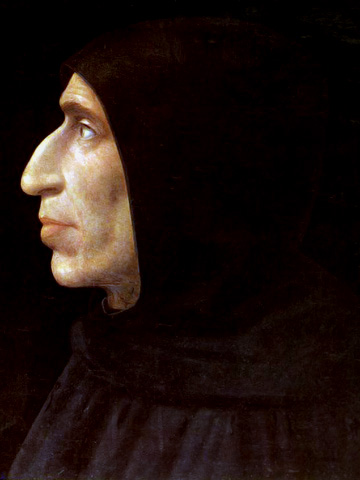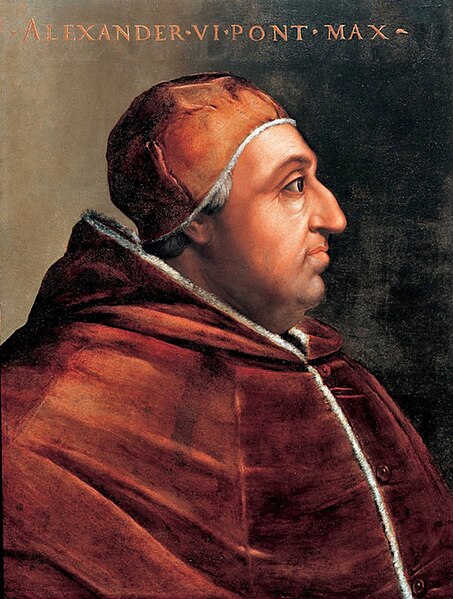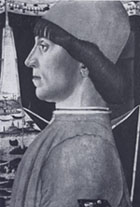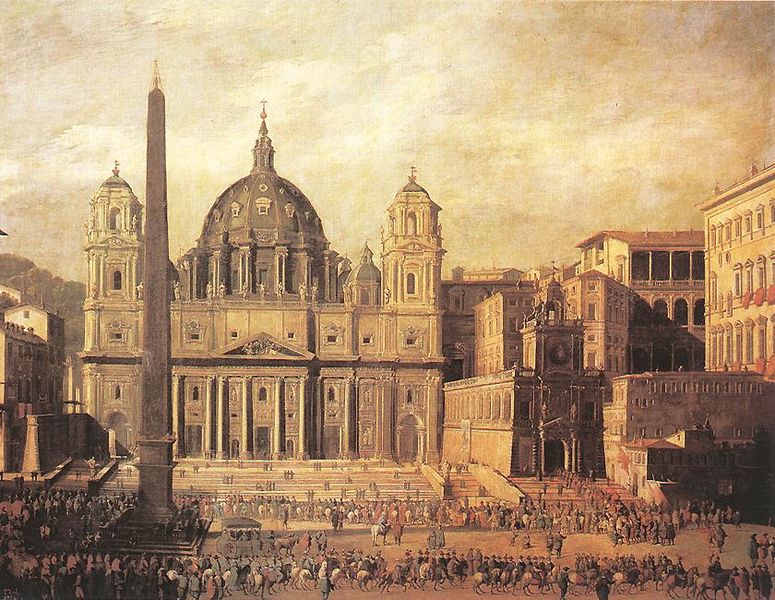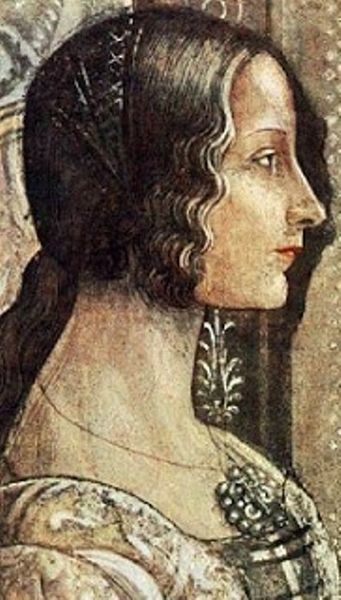 |
| Charles VIII of France |
The Controversy Deepens
Charles VIII
determined to make good his claim to the throne of Naples and during 1493
summonsed a commission at Tours to validate his intention to storm into Italy. He
also intended to call a council calling for the deposition of Alexander VI on
the grounds of simony[i]. This idea had been
planted in his head by della Rovere, who had come to France deliberately to
find allies to destroy Rodrigo.
Della Rovere
frequently appears unbalanced in his detestation of the Borgia family. This
time he claimed that a pope;
‘So full of vices, so
abominable in the eyes of the world’[ii]
must be
removed. Della Rovere was not disturbed by the possibility of creating another
schism[iii] in the church and his
ambitions led to four years of war in Italy[iv]. Charles was
impressionable and was subjugated by this forceful prince of the church[v].
_-_Bianca_Maria_Sforza_(Kunsthistorisches_Museum_Wien).jpg) |
| Bianca Maria Sforza |
Charles’
planned invasion was assisted by the uncertainties in the Sforza family where
Ludovico had refused to resign his regency when Gian Galeazzo, Duke of Milan,
came of age. Gian Galeazzo’s wife Isabella[vi] complained to her grandfather
Ferrante of Naples. Ferrante’s violent response convinced Ludovico that safety
lay in deposing his opponent.
Ludovico
allied himself with Ferrante’s disaffected nobles and invited Charles into
Italy[vii]. In October 1494
Ludovico Sforza finally procured the ducal title for himself after providing a
dowry for his niece Bianca Maria, who was marrying the Holy Roman Emperor, Maximilian.
In September
1494 a French army of 60,000 crossed the Alps. A panicking Rodrigo allied the
church with Florence and Naples, the alliance quickly fell apart.
Since 1490 Savonarola
had been preaching in Florence protesting corruption in the church and
demanding reform; his calls were ignored by the rulers of the city and by
Rodrigo. On 9th November 1494 the de’ Medicis were expelled from
Florence and a republican government was established. The French were invited
in to the city.
 |
| French troops enter Florence |
Charles’
troops then marched on Rome which fell, unresisting, to the French. Their armed
parade took six hours to enter the city, including 36 cannon on wheels. The
pressure to maintain the invaders was heavy;
‘Requisitions are fearful,
murders innumerable, one hears nothing but moaning and weeping. In all the
memory of man the Church has never been in such an evil plight.’[viii]
 |
| French troops enter Naples |
Rodrigo
refused to hand over Castel Sant’Angelo or invest Charles with the throne of
Naples, although he did give Charles right of passage through Naples territory.
Despite attempts by della Rovere to push Charles into deposing Rodrigo, Charles
was more focussed on his final objective, Naples.
Alfonso
abdicated and entered a monastery; his son Ferrante scarpered whilst the French sacked
Naples and ravaged her territories. It was Spain which organised resistance;
worried about the French military presence in Italy; Ferdinand of Aragon
offered his daughter Johanna[ix] as a bride for Maximilian’s son Philip.
Changing Alliances
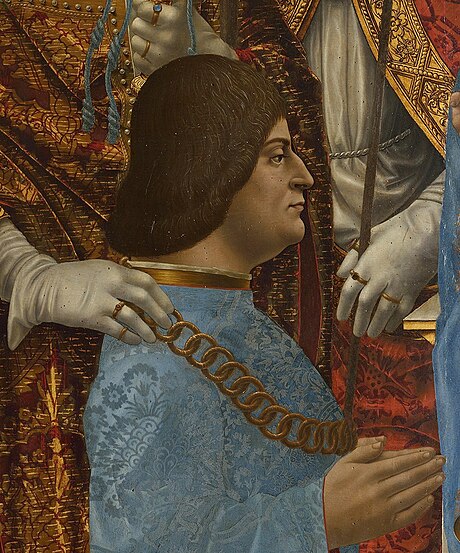 |
| Ludovico Sforza |
The
following year saw Spain and the Holy Roman Empire joined in alliance with the
papacy and Milan and later Venice[x]. Savonarola’s enemies were
manifest and included Ludovico Sforza who wanted Florence to join the Holy
League, a move opposed by Savonarola.
In Florence,
Savonarola’s teachings inspired bonfires on which the Florentines would burn
paintings, valuables, clothes and jewellery. Bands of children scoured Florence
for vanities to burn. Like Zamometic
before him, Savonarola’s call for reformation of the manifold iniquities of the
church fell on deaf ears.
‘Popes and prelates speak
against pride and ambition and they are plunged in it up to their ears. They
preach chastity and keep mistresses…..They think only of the world and worldly
things; they care nothing for souls.’[xi]
It was when
Savonarola hailed Charles VIII as an instrument of reform sent by God that he
was seen as really dangerous by the authorities. Rodrigo did nothing to silence
the friar’s writings, although he was forbidden to preach.
 |
| Battle of Fornova |
The French
meanwhile had made themselves hated in Naples and marched homewards. They
fought the league, under the command of Francesco II Gonzaga of Mantua; at Fornovo[xii]. The battle on 6th July
1495 was indecisive and the French continued their retreat. Alfonso and
Ferrante popped back into Naples and resumed their rule.
End of a Worthy Opponent
Rodrigo was
finally moved to excommunicate Savonarola in June 1497. The friar had ignored
the ban on his preaching and he ignored the excommunication likewise,
celebrating the Missa Solemnis on Christmas Day. Rodrigo demanded
that the rulers of Florence either lock Savonarola up, or send him to Rome; if
not he would lay Florence under an interdict.
In response Savonarola
wrote to Rodrigo;
‘I can no longer place any
faith in Your Holiness, but must trust myself wholly to Him who chooses the
weak things of this world to confound the strong. Your Holiness is well advised
to make immediate provisions for your own salvation.’[xiii]
 |
| Death of Savonarola |
He also
turned on the Florentine Signoria; but Savonarola’s supporters were
wearying, worn down by bad harvests and broken promises. Charles VIII promised
to return Pisa to Florence but had then reneged and
the Florentines were now caught up in a war against their former satellite.
In May 1498 Savonarola
was arrested and tortured and then hung in chains and burned.
‘Part of their bodies
remained hanging to the chains, a quantity of stones were thrown to make them
fall, as there was the fear of the people getting hold of them; and then the
hangman….hacked down the post and burned it on the ground…..stirring the fire
up over the dead bodies so that the very last bits were burned.’[xiv]
Savonarola
was freed from the fear of purgatory as Rodrigo had shown mercy to his
adversary and granted Savonarola a plenary indulgence.
Death of a Son
 |
| Painting believed to be of Juan Borgia |
On 14th
June1497 Rodrigo’s favourite son Juan was murdered after dining with Cesare at
his mother’s house. Juan’s dead body was found in the Tiber[xv];
‘On learning that the duke
was dead and had been thrown like dung into the river, the pope was deeply
moved and shut himself away in a room in grief and anguish of the heart,
weeping most bitterly.’[xvi]
And the
rumour mill cited a jealous Cesare as being involved in his brother’s death[xvii].
Juan’s
brother Joffré had reason to wish Juan dead, as Juan had bedded his wife
Sancha. There was no shortage of suspects which included the Sforzas, Giovanni,
Ascanio and Gian Galeazzo, not to mention the Duke of Urbino[xviii] and the Orsini. No-one was ever
convicted of the murder of the pope’s beloved son.
Following
Juan’s death and a period of introspection, Rodrigo announced the setting up of
a commission to reform the church claiming, and there is no reason to doubt his
sincerity at the time;
‘We will begin the reform
with ourselves and so proceed through all levels of the church till the whole
work is accomplished.’[xix]
The
commission produced little of any lasting value; cardinals were to have their
income of 6,000 ducats per annum[xx] reduced along with their
households which should number no more than 80 persons, of which at least 12
should be in holy orders. Mounted escorts were to be reduced to 30, cardinals
were to eat more abstemiously, cease attending theatricals, tournaments and
were no longer to employ youths as
body servants.
In addition
all concubines were to be dismissed immediately; here Rodrigo lost interest. The
proposed bull In apostolicae sedis
specular was never published and the question of reform was dropped. A
chance to alter some of the abuses at the pinnacle of the church was lost and
the path to the reformation continued apace.
A Second Marriage
 |
| Coin showing head of Giovanni Sforza |
Cesare seems
to have been prime mover in persuading his father to annul his sister’s
marriage to a scion of the Sforza family on the grounds of non-consummation of
marriage; a charge that Giovanni Sforza denied vehemently, writing to his
cousin Ascanio;
‘I do not want to agree to
this dissolution for no man under God could do so, and even were I to give my
consent it would be invalid owing to things that have passed between me and
Madonna Lucrezia as I explained……[to] the most illustrious Lord Duke [of
Milan].’[xxi]
There was
also of course the question of returning Lucrezia’s dowry of 30,000 florins[xxii]. Giovanni put out the
rumour that the pope was demanding the return of his daughter to bed her
himself. The rumour was given credence by the vices of his sons and soon the
wags in Rome added to the tale; the late Juan de Borgia and his brother Cesare
were also indicted with the crime of incest. Nevertheless Giovanni’s wishes
were ignored, the annulment proceeded and the dowry was returned.
The biddable
Lucrezia was secretly married on the 21st July 1498 to Alfonso of Aragon, the illegitimate son of Alfonso of Naples. Alfonso
was Duke of Bisceglie and Prince of Salerno.
Bibliography
At the Court
of the Borgia – Johan Burchard, Folio Society 1990
Italian
Dynasties – Edward Burman, Equation 1989
Lucrezia
Borgia – Rachel Erlanger, Michael Joseph 1979
Florence and
the Medici – JR Hale, Phoenix Press 2001
The Rise and
Fall of the House of Medici – Christopher Hibbert, Folio Society 2001
The Borgias
– Mary Hollingsworth, Quercus Editions 2014
Scourge and
Fire – Lauro Martines, Jonathan Cape 2006
The Borgias
– GJ Meyer, Bantam 2013
A History of
Venice – John Julius Norwich, Penguin Books 1982
Absolute
Monarchs – John Julius Norwich, Random House 2011
A
Renaissance Tapestry – Kate Simon, Harrap 1988
The March of
Folly – Barbara Tuchman, Cardinal 1990
www.wikipedia.en
[i]
Trading in sacred objects
[ii]
The March of Folly - Tuchman
[iv]
As pope the rigours of war on his subjects did not worry della Rovere; the most
war-like of popes
[vi]
Alfonso of Naples’ daughter
[vii]
A risk, as Charles had a stronger claim to Milan than to Naples through his
ancestor Charles
of Orléans
[viii]
The March of Folly - Tuchman
[ix]
Known as Johanna the Mad; Johanna was Katherine of Aragon’s sister
[xi]
The March of Folly - Tuchman
[xii]
In Lombardy
[xiii]
The Rise and Fall of the House of Medici - Hibbert
[xiv]
Ibid
[xv]
The title was inherited by his son Juan de Borja y
Enriquez,
[xvi]
At the Court of the Borgia - Burchard
[xvii]
Although he has been absolved of the crime by historians
[xviii]
One of the della Rovere family
[xix]
The March of Folly - Tuchman
[xx]
In 2013 the relative: historic standard of
living value of that income or
wealth is £3,948,000.00 economic status
value of that income or wealth is £109,800,000.00 economic power value of that income or wealth is £1,579,000,000.00 www.measuringworth.com
[xxi]
Lucrezia Borgia - Erlanger
[xxii]
In 2013 the relative: historic standard of
living value of that income or
wealth is £20,980,000.00
economic status value of that income or wealth is £567,200,000.00 economic power value of that income or wealth is £8,123,000,000.00 www.measuringworth.com
economic status value of that income or wealth is £567,200,000.00 economic power value of that income or wealth is £8,123,000,000.00 www.measuringworth.com
